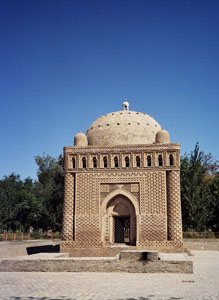Information about city Bukhara in Uzbekistan
Bukhara
Bukhara is an ancient settlement going back to the early centuries A. D. In the sixth Century it became the capital of early feudal lands of the Bukhara oasis. As the shakhristan, the centre of a shah's realm, it was formed around an ancient citadel, but with the development of handicrafts and trade new suburbs (rabads) arose beyond its walls which were included wilh the shakhristan in a new fortified wall. Remains of dating back to the sixteenth Century have survived to our day. Bukhara preserves genuine treasures of architecture of the pre-Mongol period, although not very many in number. One of them is the mausoleum of the Samanids built in the ninth-tenth Century.
The modest structure is, by virtue of its artistic aspect and the lucid logic of its construction, a true monumental piece of architecture. The art of construction, the virtuoso use of fired brick in decoration, and the lay-out of the building place it among the masterpieces of world architecture. The architecture of the following period is better expressed in the Kalyan minaret, built in 1127, at the same time as its Fri-day mosque (for prayer of the assembly, observed on a Friday) which no longer exists.

The powerful column of the minaret-is 9 metres in diameter at the foundation and grows slightly narrower towards its 46 metre height. The minaret is exquisite not only in its magnificence and ornamental brick work but also for the art with which it was built. It has stood for 800 years now without once needing repairs. Outside the walls of Bukhara stands the namazgah, a mosque for five-times daily private prayers (built in 1119—1120}, with sixteenth century triple-arch gallery.
The south portals of the Magoki-Attari mosque is highly characteristic of the very decorative architecture of the twelfth century. The decorative details of the portals are famous because of the fine techniques involved. The few Bukhara masterpieces extant of eleventh and twelfth centuries testify to the splendid building skill of the architects ol the period, the subtle artistry of their ornamentation.

In the post-Mongol period there were no extensive construction work in Bukhara and in other cities of Central Asia. But in the next century there was increased activity in this sphere. In the time of Ulug Beg Bukhara acquired a new madrasah (1417). Everything in it is characteristic of Ulug Beg architecture' clarity of the design, excellent proportions, and understated decorative details.
In the sixteenth century, after the establishment of the Uzbek Shaibanai dynasty, Bukhara once again became the capital of a large Central Asia state. The city grew and new walls were built. The intensive construction here started with a Friday mosque, erected in 1514 in the place of an older twelfth century mosque beside the Kalyan minaret. It became one of the biggest structures in Central Asia. On the other side of the square in which the minaret stands the Miri-Arab madrasah was built in 1535—1536. The madrasah, the mosque and minaret comprise one of impressive ensembles in Bukhara.

The same method of kosh, in other words, of paired buildings, was used in the construction of the madrasahs, the Mo-dari-khan (1566—1567) and the madrasah of Abdullah-khan (1588—1590). The architecture of small town mosques combined the technique of monumental architecture and popular tradition. Such are the Balyand and Khoja Zaineddin mosques (16th cen.). The ornamental design of their interiors is on a par with the best Samarkand structures of the fifteenth century. Civil building played an important role in sixteenth century Bukhara architecture: the bazaar takis, caravanserais and baths. They are extremely expressive in their clear-cut silhouettes and constructional solution.
One of the important Bukhara ensembles, the buildings around the Lyabi-khauz date back to the seventeenth century. The earliest of them, Kukeldash madrasah (1568—1569) is the largest building in Central Asia among similar structures. In 1620 the Lyabi-khauz pool was dug in front of it, faced with large lime flagstones and its perimeter planted with trees. At the same time, on the two sides of the pool were built the khana-gah, a mosque and hospice, and the Nadir-Divan-Begi madrasah. The structures stand by the extensive surface of water in a most effective way.

The kosh technique was also used in the construction of the last important Bukhara building, the Abdulazis-khan madrasah (1652), opposite the Ulug Beg madrasah. Despite the fact that the two buildings differ in dates of construction, divided as they are by two centuries, they comprise a united and austere architectural ensemble.
In the eighteenth century, owing to the political situation, the construction in Bukhara lost its former creative power. The individual buildings and whole ensembles of Bukhara played a great role in urban construction and continue to do so even today. The technique of placing them in groups in certain combinations strengthened their artistic influence and gave the finishing touches to the squares and thoroughfares of the city. It is in this that the importance of the architectural ensembles of Bukhara lies. Restored and preserved, they have now acquired a new lease of life, and comprise an integral part of the modern city's aspect.












 Kazakhstan
Kazakhstan Kyrgyzstan
Kyrgyzstan Tajikistan
Tajikistan Turkmenistan
Turkmenistan Uzbekistan
Uzbekistan